Access points associated with a traffic-free route or greenway should be designed to provide access to all legitimate users of the route. This section provides an overview of the design of access points, access controls and the removal of restrictive accesses.
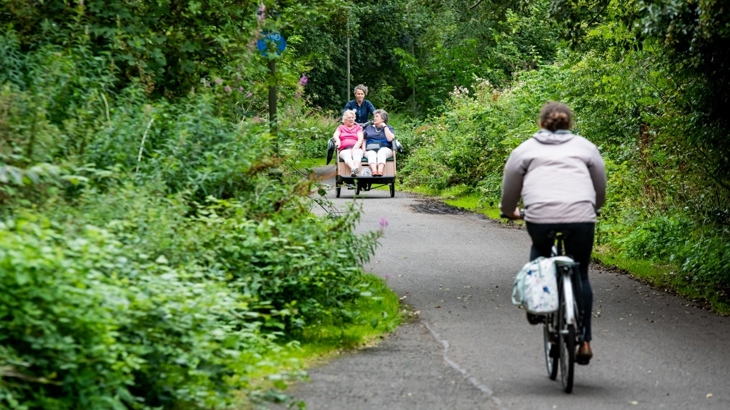
Photo: Andy Catlin/Sustrans
Key principles
- Access to traffic-free routes should be available to all legitimate users.
- Access points should invite users onto the traffic-free route.
- There should be a general presumption against the use of access control measures.
- Where any controls at access points are absolutely necessary, they should not restrict access to legitimate users.
- Access controls should not usually be required to simply control speeds on the approaches to roads or crossing points.
- Access controls may be required to prevent unauthorised access by motor vehicles or to control livestock.
9.1 Access point requirements
9.1.1
The overriding design requirement for an access point is that it is accessible to all legitimate users of a traffic-free route.
A poorly designed access point can serve to exclude users from routes.
Particularly where designers have placed too much emphasis on preventing access by motorised vehicles.
All current design guidance, including Local Transport Note 1/20 (Section 8.3), Welsh Active Travel Act Design Guidance (Section 15.3), Cycling by Design (Section 3.5), London Cycling Design Standards (Section 4.5.15) and Highways England CD 195 (Paragraph E/3.35) states that restrictive access control barriers should not be provided on traffic-free routes.
9.1.2
Designers must fulfil their duties under the Equality Act 2010 when designing access points.
9.1.3
Any access point should have a minimum clear width of 1.5 metres.
Any access point should be able to accommodate the design cycle vehicle (which is 1.2 metres wide x 2.8 metres long).
9.1.4
It is important that an access point does not restrict the flow of users along a traffic-free route.
Provision should be made for two-way flow, which may require a minimum provision of two 1.5 metre wide clear gaps.
Access points are often places where people will pause to confirm directions, take a break or stop for other reasons.
Therefore, consideration should be given to providing sufficient space beside access points for path users to stop safely and away from the road.
Additionally, when this space is in use, access to the path should not be blocked for other users.
Where access points are set back from the edge of a road, designers should consider how to prevent the access point being obstructed by parked vehicles.
9.1.5
Designers should also consider the travelled path of all users passing through an access point.
Where a user has to complete turning manoeuvres to negotiate an access point, the layout should be tracked to ensure that it can be used by the design cycle vehicle.
The effects of gradients and cross-falls need to be taken into account in this assessment.
An alternative approach to using tracking software could be to mark out the layout of an access point using temporary materials and test it with a range of types of cycle.
The advantage of this approach is that designers can assess the level of comfort and complexity of moving through an access point feature themselves.
The local community and accessibility groups can also be involved in these trials as a part of stakeholder engagement.
9.1.6
Access points are an important element of traffic-free routes and are a gateway onto the route.
As such, they should welcome people onto the traffic-free route by being open and accessible.
Access points should enhance both the amenity of an area and the traffic-free route.
Designers should therefore consider scale, materials and colours carefully.
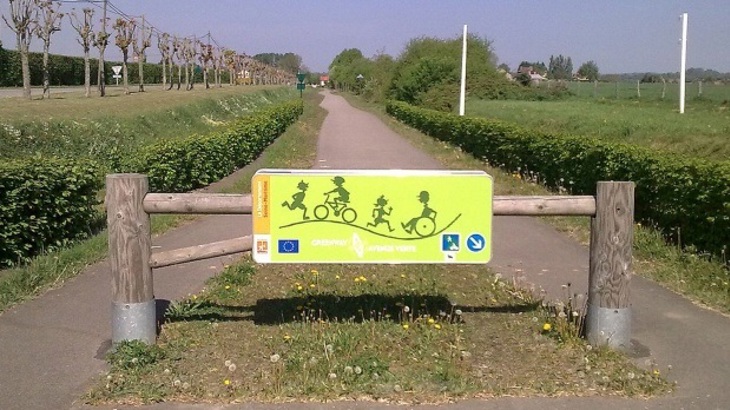
Open and welcoming access point on Avenue Verte (running from Dieppe to Forges-les-Eaux, France). Photo: Nick.x5d, CC0, via Wikimedia Commons https://commons.wikimedia.org/w/index.php?curid=15061793
9.1.7
Designers should engage the local community in the design of access points.
Consideration should be given to working with local artists, urban designers and schools to produce designs for access points.
It might be appropriate to run design competitions to encourage community participation.
Access point designs may provide an opportunity to capture local history or features that are unique to an area.
In doing this, the community can be proud of a feature which they have helped to develop and install.
This approach will also provide opportunities for younger members of the community and visitors to learn about the area.
9.1.8
Consideration should be given to the visibility of any access point features which encroach into the clear width of the traffic-free route, including the immediate verges.
Consider not only those who use the path during hours of darkness or in low light, but also people with sight loss or visual impairment.
9.1.9
Where access points involve ramps, these should be designed in accordance with the guidance provided in section 7 of this traffic-free routes and greenways design guide.
9.2 Preventing unauthorised access
9.2.1
In some cases it may be necessary to provide measures which control access to a traffic-free route by unauthorised users.
Whenever access control measures are required they should be configured so that access is not restricted for legitimate users.
9.2.2
Motor vehicle access can usually be prevented by reducing the clear gaps at an access point.
A clear width of 1.5 metres will prevent access by most motor vehicles.
This can often be achieved with the provision of bollards across an access point.
Where bollards are provided they should be visible during hours of darkness or in low light levels.
This visibility can usually be achieved with the provision of reflective bands on the bollards.
Consideration of the colour of a bollard is important so that they are visible to people with sight loss or visual impairment.
9.2.3
Restrictive access controls are frequently provided to restrict unauthorised access by powered two-wheelers (including motorcycles and trail/dirt bikes).
Simple dimensional considerations mean that any control that will prevent access by a powered two-wheeler will also prevent access by the cycle design vehicle.
Additionally, there may be other ways for a powered two-wheeler to gain access to a route, for example through a gap in the boundary elsewhere.
Anti-social behaviour will generally be more effectively managed through enforcement.
Anecdotally, increased usage of a route may also reduce anti-social behaviour.
Where anti-social behaviour is known to be a problem on an existing route, evidence of actual incidences should be gathered to inform any decisions.
This may include video surveys or reviewing police records.
9.2.4
It may be necessary to facilitate vehicular access through an access point.
This may be for maintenance vehicles or for emergency services.
The simplest approach is likely to be the provision of a removable bollard which will turn two 1.5 metre wide gaps into a single 3 metre wide gap.
Removable bollards should be secured with padlocks or similar.
Consideration should be given to the manual handling requirements of removable bollards.
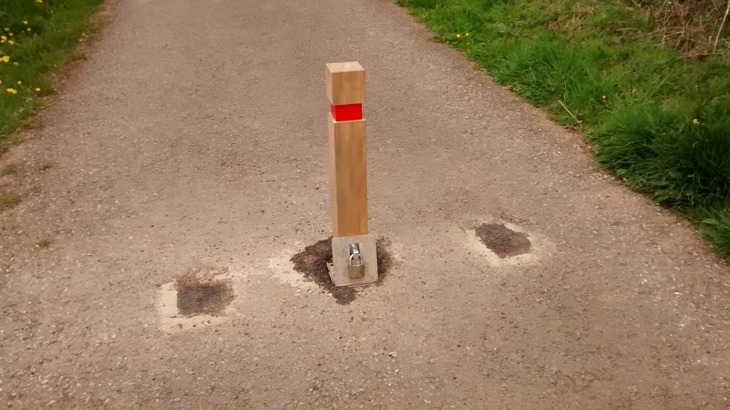
Removable timber bollard with reflective banding.
Where there is sufficient width, a separate lockable gate could be provided for vehicular access.
This could be provided centrally or to one side of the access point, noting the need to provide a minimum of one (but ideally two) 1.5 metre clear gaps.
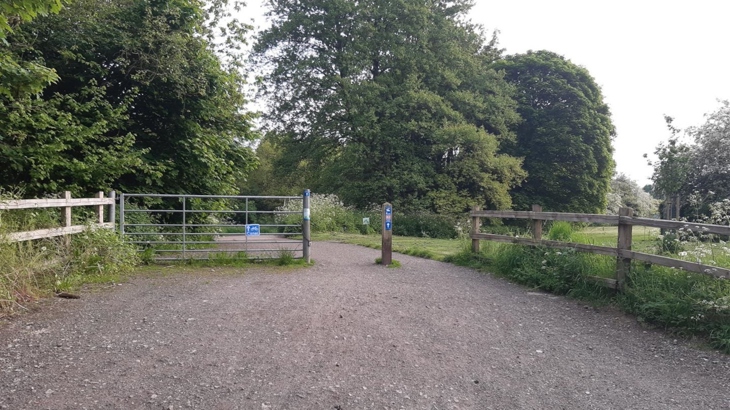
Vehicle gate adjacent to two 1.5 metre wide gaps for traffic-free route user access. Note the path surface is not a sealed surface.
Where staggered access controls such as chicanes are used, each panel can be installed as a gate.
One or both panels can then be unlocked and opened to enable access by vehicles.
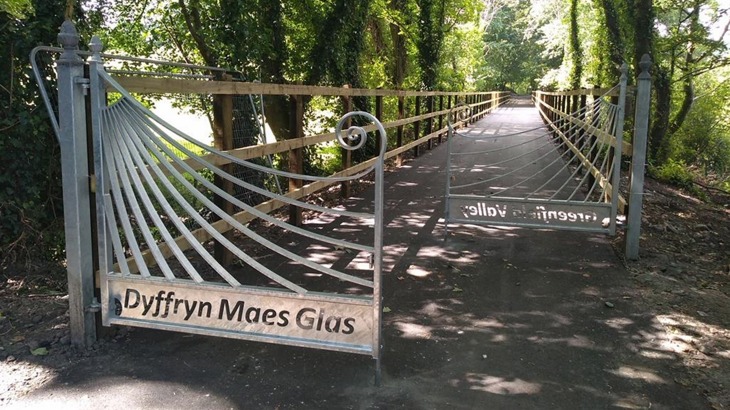
Opening gates on Greenfield valley path, Holywell, Flintshire. Note the barrier may not be as visible as it could be due to the barrier colour and the effects of light and shade.
9.3 Access points at roads
9.3.1
Where a traffic-free route joins or crosses a road, particular attention should be given to the design of the access point.
Users of the traffic-free route need to be aware of the road and footway ahead of them, and of the need for them to approach at an appropriate speed.
Likewise, users of the road and adjacent footway need to be aware of the traffic-free route.
A common approach in this situation has been to provide a barrier at the access point to physically prevent users of the traffic-free route from accessing the road at speed.
However, such barriers can restrict or prevent access onto or off of the traffic-free route.
A designer will need to reconcile potential tensions between the requirement to provide inclusive access and the need to mitigate any risks associated with an access point.
This may require the equality impact assessment process to be balanced with the road safety audit process.
9.3.2
Access controls, including chicanes, should not usually be required simply to control cyclists on the approach to a road or footway crossing.
It will often be possible to design the approach to a road or crossing point such that users clearly understand the need to take additional care and give way to other users, without providing restrictive barriers.
9.3.3
Where a traffic-free route approaches a road or crossing point, it is essential that users of the traffic-free route are made aware of the road or crossing point through good visibility to and from the crossing point, and the provision of appropriate signs and markings.
9.3.4
Road users, including those on an adjacent footway, should be provided with adequate warning of the access point for the traffic-free route.
This may include ensuring that there is sufficient visibility of the access point, along with the provision of warning signs.
Guidance on the provision and siting of warning signs is included in Chapter 4 of the Traffic Signs Manual.
The use of variable warning signs for road users, which are activated by users of the traffic-free route approaching the access point, may provide a more targeted warning.

'Cycle route ahead’ warning sign (TSRGD Diagram 950). The supplementary plate 'Cycles crossing' may be provided where there is a crossing as opposed to a traffic-free route joining the road. Note the positioning of the sign on the off-side of a single lane road, which enhances its visibility.
9.3.5
Providing a change in direction on the approach to a road or crossing point can encourage path users to slow down on the approach.
This can also disrupt any through sight lines along the line of the traffic-free route.
Any changes in route alignment should still provide path users with enough advance warning of the road or crossing point, and so may need to be supplemented with signs and markings.
Any changes in direction in the route alignment should be navigable by the cycle design vehicle.

A change in direction on the approach to an access point onto a road. Note that warning signs and markings could have also been provided.
9.3.6
Warning signs and surface markings should also be considered to communicate the approach to a road or crossing point.
This could include messages such as ‘Busy road/Road ahead’ or ‘SLOW’ and give way markings.
The provision of a warning sign in the middle of the access point may be appropriate.
This could be incorporated with a feature to prevent motor vehicle access.

Warning signs on the approach to a road crossing. Also note the slight stagger in the crossing alignment which reduces the through visibility along the line of the traffic-free route. The two warning signs should be rationalised. Note the surface quality is not ideal.
9.3.7
Where changes in path alignment, signs and markings, or non-restrictive controls such as bollards are not considered sufficient to mitigate the risks in a particular situation, staggered barriers or chicanes may provide a solution.
Staggered barriers or chicanes can restrict access if not carefully designed and so should be subjected to tracking by the design cycle vehicle.
They may also impede two-way flow on a route.
The layout of such controls should be designed on a location specific basis.
Where staggered barriers or chicanes are provided, they should be considered to primarily function as a visual clue that users are approaching a road or crossing point, as opposed to a physical measure.
As such, they are likely to require a significant distance between the two elements of the barrier.
When designing staggered barriers or chicanes, it is best practice to locate the first panel on the nearside of the path.
This will encourage a greater speed reduction before users are required to change their direction.
The panels themselves do not have to overlap.
The image below is an example of an access point where opportunities to change the path alignment were constrained due to the path being on an embankment.
Staggered barriers or chicanes have been used to indicate to users the need to slow down on the approach to a crossing point.
In this case, the panels have incorporated artwork and route numbering.
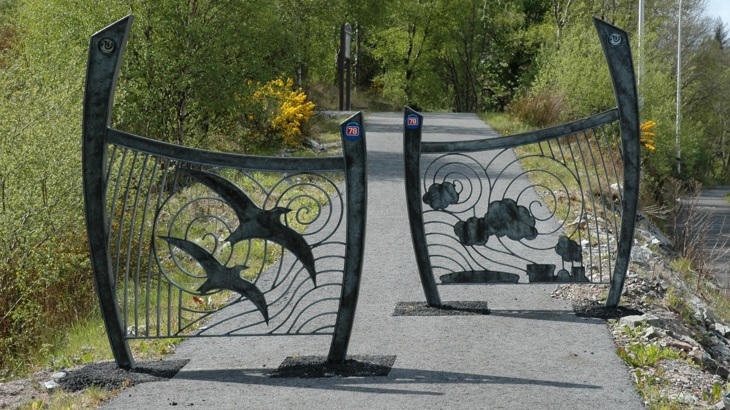
Staggered barrier/chicane access point incorporating artwork on National Cycle Network Route 78.
9.4 Agricultural crossings and livestock control
9.4.1
Traffic-free routes often have interfaces with, or are situated alongside agricultural land.
As such, landowners, tenants and farmers will sometimes need access across or along a traffic-free route.
This access may be required to transport materials, vehicles or livestock between land and buildings.
There are a number of solutions for providing agricultural crossings and access.
Designers must understand the needs of a landowner or tenant to ensure that the most appropriate crossing is provided.
A poorly designed crossing could have a negative impact on agricultural operations, as well exclude users from the traffic-free route.
9.4.2
In some cases, farming activity may require vehicular and livestock movements along a section of traffic-free route.
This may be to access sections of land or agricultural buildings.
These access requirements will be a key consideration during the design process and should be determined through a stakeholder engagement exercise.
Designers should seek legal counsel and planning advice when negotiating access requirements.
This will assist in understanding the legal status of the route and any lawful requirement to provide access to stakeholders, landowners and tenants.
9.4.3
Designers should develop an understanding of the frequency and loadings imposed by agricultural movements.
This will need to be considered when determining the specification for the path construction.
The movement, including the turning of heavy agricultural vehicles such as tractors, will need a more substantial path specification.
This will help to avoid path failure and damage.
This can usually be provided with a reinforced concrete pad at the crossing.
Where adjacent landowners or stakeholders need access across or along a traffic-free route, designers must consider the frequency and timings of such movements to understand how this could serve to affect users of the route.
9.4.4
The simplest form of controlling the interface between the traffic-free route and an agricultural crossing or movement is to implement a short-term temporary closure of the traffic-free route.
This can be achieved by fully opening the gates of the agricultural land, which then serve to close across the traffic-free route, as shown in the image below.
This arrangement can cause delay to users of the path, particularly where movement of agricultural vehicles, equipment or livestock is likely to take more than a few minutes.
This type of crossing may only be suitable where movements across the traffic-free route are low in frequency and low in duration.
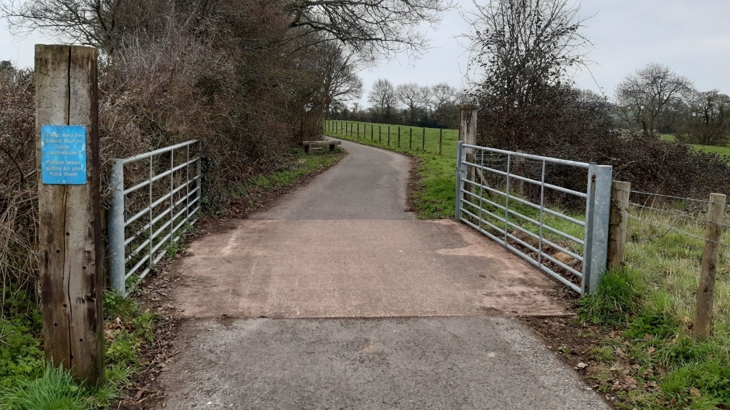
Simple agricultural crossing with reinforced concrete pad.
9.4.5
Where it is necessary to control livestock at an access point, well-designed cattle grids with a minimum clear width of 1.5 metres can provide unobstructed access for many people cycling.
However, they can exclude other users, including those walking, wheeling or riding horses.
Providing a gated access (minimum clear width 1.5 metres) next to the cattle grid can provide an alternative route through the access point.
However, the design of the gates and their method of operation, including two-way latches, must take all users into account so that access is not restricted.
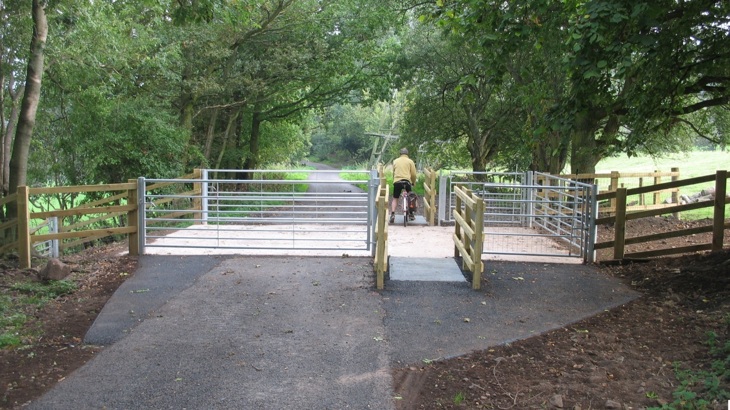
Gated agricultural crossing with cattle grid.
9.4.6
Where horse riders use the route, the specifications of any livestock control features need to ensure that access by horse can still be achieved.
Further guidance can be found on the British Horse Society website.
9.4.7
One of the hazards associated with cattle grids is that the bars can be slippery.
To mitigate this, the designer should give consideration to the location and layout of the cattle grid to avoid the need for users to have to turn on, or in the immediate vicinity of the cattle grid.
Consideration should be given to the profile and finish of the bars.
Flat topped bars (rectangular section) can provide a greater level of comfort but may need to have an anti-slip finish applied.
The use of large diameter, galvanised threaded reinforcement bars can provide a relatively non-slip solution but may have a lower level of comfort.
9.5 Removal of restrictive access controls
9.5.1
There may be opportunities to address restrictive access controls when an existing traffic-free route is being improved.
In these situations, designers should consider whether removing access controls entirely is feasible.
Where this is not possible, designers should upgrade the access control using this guidance.
Regardless of the approach, designers should consult with accessibility groups and other stakeholders.

